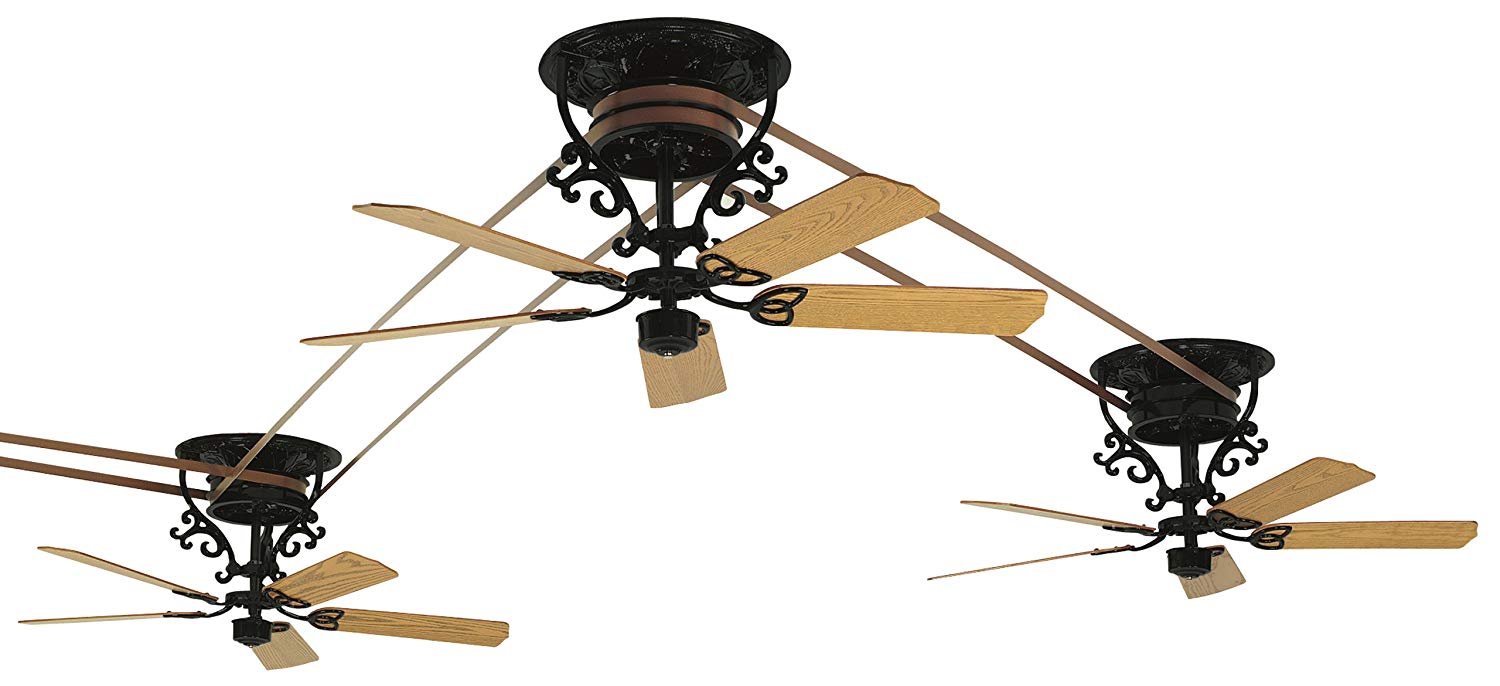 Ceiling fans can be very useful in the heat of the summer and even in the cold of the winter. In addition, they can make or break the styling of your interior. If you were thinking about adding a ceiling fan to your home, we may have something interesting for you.
Ceiling fans can be very useful in the heat of the summer and even in the cold of the winter. In addition, they can make or break the styling of your interior. If you were thinking about adding a ceiling fan to your home, we may have something interesting for you.
A belt driven ceiling fan may be the item that you so desperately need for your interior. And to help you understand whether you need one or not, we are going to learn what they are. And besides, we’ll showcase a couple of belt driven fans to help you get a better idea of what they are.
Table of Contents
How does a belt driven ceiling fan work?
Unlike regular direct-drive ceiling fans, the rotation of the fan in belt driven fans – also called pulley-driven fans – is powered by a motor unit that is separate from the housing.
The motor and the belt driven ceiling fan are both installed on the ceiling within a certain distance from each other. The motor and fan units have flywheels that are connected with a belt. Rotating the flywheel, the motor brings the belt into motion which rotates the fan.
In direct-drive ceiling fans, there is no system of belts. Instead, the energy produced by the motor is directed to rotating the fan.
Is this an efficient fan?
Belt driven fans can be pretty efficient. However, generally speaking, they are less efficient than direct-drive fans.
To illustrate this, let’s assume we have two ceiling fans – one direct-drive and one belt driven – both with the same wattage.
Because direct-drive fans transfer power directly into rotating the fan, there is little to no energy loss observed in them.
In belt driven ceiling fans, the use of belt systems can result in energy losses of as much as 20% on small fans and 3-4% in ceiling fans with larger motors.
So yeah, when it comes to energy efficiency, belt driven ceiling fans aren’t as efficient as traditional ceiling fans. Belt driven fans can consume very little energy, but they will most likely bring less airflow at the same energy cost.
However, when it comes to multi-fan installations, the energy efficiency of belt driven ceiling fans may be much better.
Regular ceiling fans all come with their own motor units. And the more ceiling fans you have, the higher the power draw will be.
On the other hand, since the motors of belt driven fans are separate from the housing, you can run several ceiling fans on a single motor. And running 2-3 ceiling fans with the power draw of 1 is a pretty good deal.
Obviously, the more belt driven ceiling fans you add, the lower their speeds will go. The decrease in speed isn’t that huge though. For example, Fanimation Brewmaster ceiling has the following RPM at high speed:
- 127 with a single fan.
- 106 with 2 fans.
- 89 with 3 fans.
- 76 with 4 fans.
In spite of the slower high speed, several fans should be able to create better airflow than just a single fan.
On the other hand, with multi-fan installations, the total price of the fans becomes the problem. And besides, you’ll need to have the ceiling space for them. But whether going for several-fan systems is worth it or not is up to you.
Design & style

One could say that modern belt driven ceiling fans pay homage to the very first ceiling fans that appeared in the 1860’s and 1870’s in the US.
Those first ceiling fans used a very similar belt system to rotate the blades, of which there was 2. Back then, a stream of water combined with a turbine was used to drive the belts and rotate the fan.
Needless to say, modern belt driven ceiling fans run on electricity. Thereby, they are much more compact and mess-free than their ancestors.
The original power system based on water was replaced pretty soon. The first electrically-powered ceiling fan was introduced in the 1880s. These new fans had their own motor units with no belt drives as well.
The original water-powered belt driven systems didn’t live long. But there is a certain charm in modern electrically-powered belt driven ceiling fans.
The first thing that attracts in belt driven fans is their historical significance and value.
The other factor is the overall design of belt driven systems. They have a very antique and vintage feeling to them. A belt driven ceiling fan can thereby be an excellent addition to a vintage-style interior.
One manufacturer that today produces belt driven ceiling fans is Fanimation. We think that they have done a very good job transferring the feel of the antique belt driven systems, which is why we chose to showcase their ceiling fans today.
Fanimation offers a pretty wide range of belt driven ceiling fans that could suit many interiors. And to demonstrate this, let’s now have a look at a couple of their models.
Top 7 Belt Driven Ceiling Fans to Buy
Fanimation Kellan Fan
 Up first on our reviews is Fanimation Kellan belt driven ceiling fan. If you’d like to add a more modest ceiling fan to your room, then this model may be the best option.
Up first on our reviews is Fanimation Kellan belt driven ceiling fan. If you’d like to add a more modest ceiling fan to your room, then this model may be the best option.
The Kellan belt driven ceiling fan doesn’t have any fancy decorative elements, which makes it a better suit for more restrained-style interiors. In addition, its two 56-inch blades (sold separately) colored cherry and dark walnut will better work with dark-colored furnishings.
Find the blades here: Fanimation B7966CYDWA Kellan
Find the belt here: Fanimation BM30 Brewmaster Belt Roll
Find the motor here: Fanimation Kellan Ceiling Fan Motor – Brushed Nickel
Aside from the remarkable design, the Kellan ceiling fan has some good power-efficiency to boast. Its motor – which is also sold separately – is rated at 37 watts at its highest speed, which is pretty low for a ceiling fan. And with the 56-inch blades delivering 4659 cubic feet per minute of airflow (CFM), you get 128 CFM/W airflow efficiency, which is very decent.
The motor of the Kellan fan has 3 forward and 1 reverse speeds, so it is pretty versatile when it comes to temperature control.
And the last thing that should be mentioned in this fan is that it is rated for dry indoor use only. It won’t survive in humid locations, let alone outdoors.
Fanimation Brewmaster Long Neck Ceiling Fan (FP1280BL-FP20BL-BMP1)
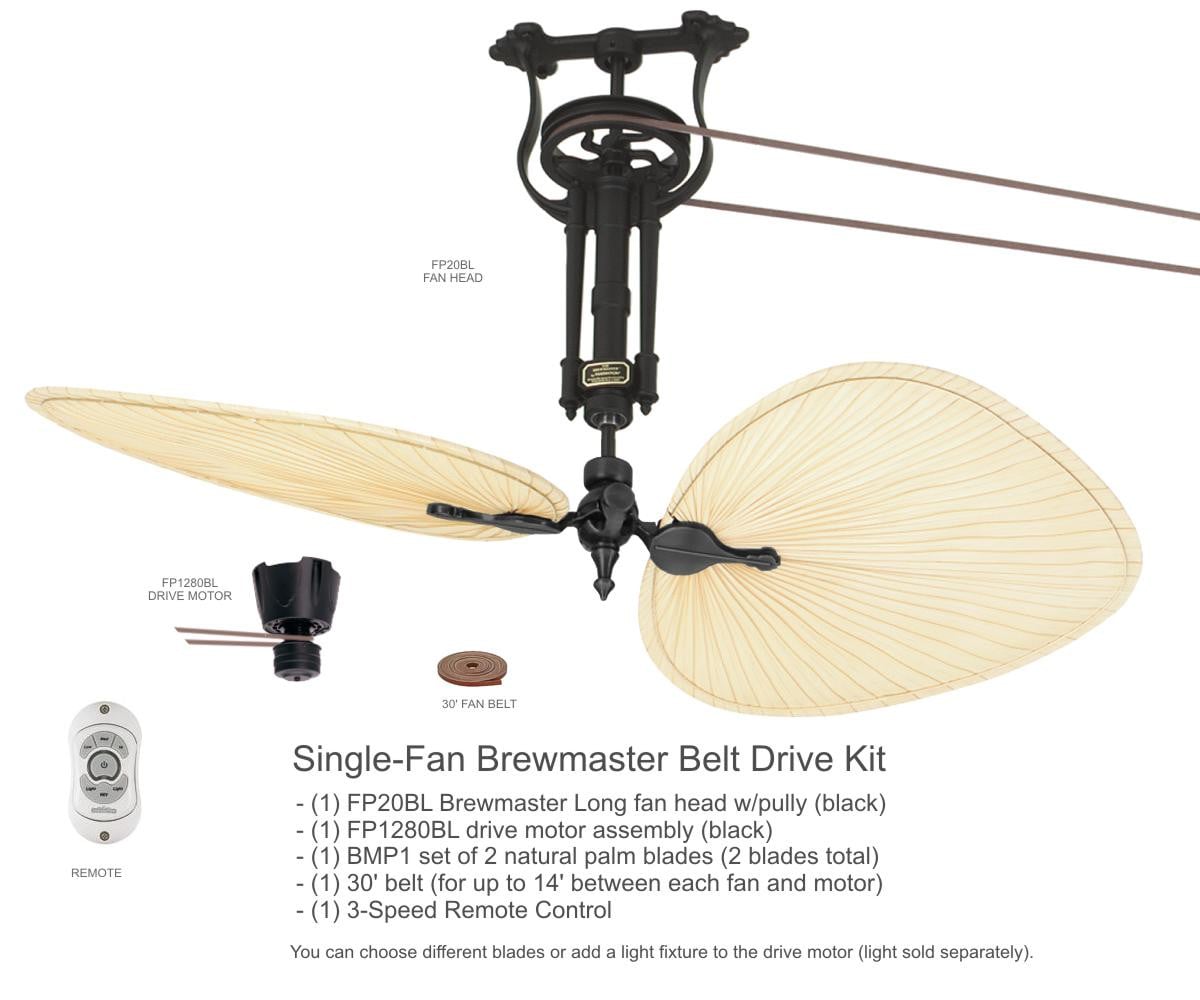 Brewmaster Long Neck FP1280BL belt driven ceiling fan has the potential to become the centerpiece of your room.
Brewmaster Long Neck FP1280BL belt driven ceiling fan has the potential to become the centerpiece of your room.
The light design of its palm leaf-shaped blades can help you greatly complement your bright-colored room. Additionally, the accentuated motor unit of this ceiling fan makes this fan feel more rustic and rough. The Brewmaster belt driven ceiling fan definitely is a better eye-catcher than the Kellan fan.
As for power efficiency and airflow, Fanimation doesn’t provide any data, unfortunately. This won’t matter for you though if looks are more important for you than performance.
Though, in terms of airflow, this fan should be a bit weaker than the Kellan ceiling fan since it comes with shorter 50” palm leaf blades. And the Brewmaster’s blades have 18-degree pitch, so they should be pretty good at moving air.
Like the Kellan ceiling fan, Brewmaster has 3 forward speeds and 1 reverse speed. In addition, the Brewmaster belt driven ceiling fan supports universal light kits, so you could add some lighting to it.
Even though some of this fan’s components are UL Damp rated, it should be used indoors only. The palm leaf blades of this thing are UL Dry rated, so they won’t survive humidity.
Fanimation Brewmaster Long Neck (FP1280BL-FP20BL-FP1026)
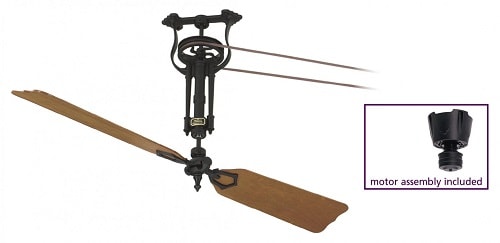 This Fanimation Brewmaster belt driven ceiling fan is almost identical to the previous Brewmaster. There is only one difference between them, which is the blades. And they are very different, mind you.
This Fanimation Brewmaster belt driven ceiling fan is almost identical to the previous Brewmaster. There is only one difference between them, which is the blades. And they are very different, mind you.
While being less of an eye catcher, the 56-inch cherrywood-colored blades allow this ceiling fan to be fitted to a wider variety of interiors. The palm leaf blades of the other Brewmaster can be truly gorgeous in certain interiors, but a fewer styles suit it.
Other than that, the two Brewmasters are identical. That’s because they are built around the same pulley mechanism and motor assembly.
This means that this Brewmaster ceiling fan has 3 forward and 1 reverse speeds and universal light kit compatibility. Again, it should be used only indoors since its blades are dry rated.
Unfortunately, the similarity also means that there is no data on the power draw and airflow for this Brewmaster ceiling fan. If we were to guess though, we’d say that its performance is closer to that of the Kellan fan we reviewed in the beginning since they have a similar blade configuration.
Fanimation 220V Brewmaster Long Neck (FP1280BL-220-FP1022)
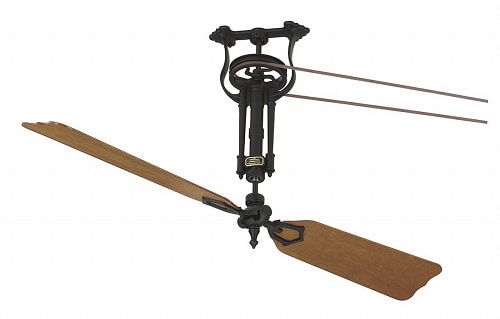 This Brewmaster ceiling fan looks familiar as well, right? It’s the exact same ceiling fan as the one that we’ve just reviewed. However, there are two differences between them.
This Brewmaster ceiling fan looks familiar as well, right? It’s the exact same ceiling fan as the one that we’ve just reviewed. However, there are two differences between them.
The first is that this one’s motor operates on 220V current. Thereby, this Brewmaster is suitable for the residents of countries where 220V current is standard. Or in any other country, as long as you need a 220V fan.
The other difference is that the blades of this Brewmaster are colored in darker oak/walnut colors, so it may be a better choice for interiors with dark accents.
Other than that, this and the previous Brewmaster belt driven ceiling fans are identical. Namely, the blades have a 56-inch span and 18-degree pitch, it has 3 forward and 1 reverse speeds, and the blades are dry rated.
Fanimation 220 Volt Bourbon Street (FA-FP580BL-220FP520BL-FP1013)
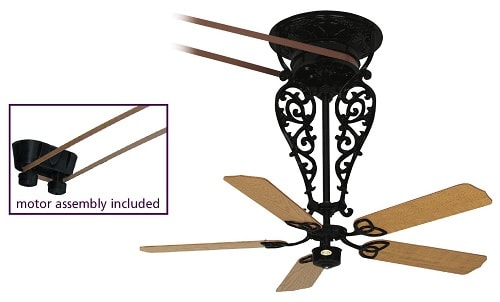 Brewmaster pulley-driven fans had a more rustic and mechanical feel with their accentuated motor unit. Fanimation Bourbon Street is a much more elegant ceiling fan.
Brewmaster pulley-driven fans had a more rustic and mechanical feel with their accentuated motor unit. Fanimation Bourbon Street is a much more elegant ceiling fan.
Everything starting from the pulley mechanism and ending with the ornamented blades makes this ceiling fan look more graceful. More high-class and elegant, if you will. If that’s exactly how you’d call your interior, then the Bourbon Street ceiling fan may be an excellent choice for you.
What’s also quite a bit different in the Bourbon Street ceiling fan is that it has 5 56-inch oak/walnut blades. And this number is pretty close to an optimum where airflow and power draw have the best balance.
So in terms of airflow, the Bourbon Street ceiling fan should have noticeably better airflow capacity than all the previous ceiling fans we reviewed. But, unfortunately, Fanimation still doesn’t provide exact figures for power draw and airflow.
What should also be noted about this ceiling fan is that it runs on 220V. There also is a 110V version of the Bourbon Street fan, which we’ll examine in a bit.
As great as this fan is, there are two things that you should keep in mind. First of all, this ceiling fan has only 1 forward speed, so you won’t be getting too much air control from it. Secondly, it should only be used in dry indoor locations.
And by the way, it should be noted that Hansen Wholesale for some reason lists this ceiling fan as the short version of Bourbon Street.
Fanimation Bourbon Street Long (1-FP580BL-FP520BL-FP1013)
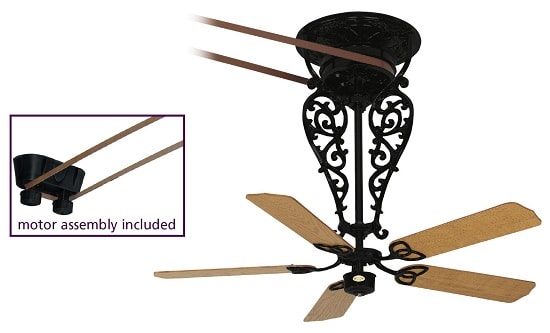 This Bourbon Street pulley-driven fan is nearly identical to the Bourbon Street ceiling fan we’ve just reviewed. There is only one difference between them: this one runs on 110V current, so it is a suitable choice for US residents, as well as residents of other countries where 110V current is standard.
This Bourbon Street pulley-driven fan is nearly identical to the Bourbon Street ceiling fan we’ve just reviewed. There is only one difference between them: this one runs on 110V current, so it is a suitable choice for US residents, as well as residents of other countries where 110V current is standard.
Other than that, the two Bourbon Street ceiling fans are identical.
Namely, the beautiful vintage design is still there, which is the most remarkable feature of the Fanimation Bourbon Street series. In addition, you get the same 5 56-inch oak/walnut blades with good airflow.
And on the not so bright side, this Bourbon Street again has just 1 speed and is rated for use in dry locations.
Fanimation 220V Bourbon Street Short (FA-FP580AB-220FP510AB-FP1013)
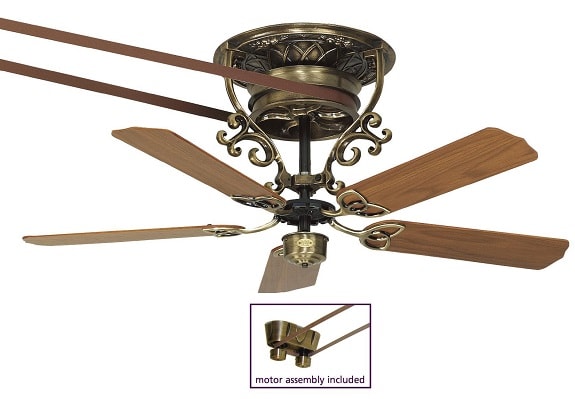 Remember how we said that the first Bourbon Street ceiling fan is the long version? Well, here is a testimony that we we’re right. This is how a short Fanimaiton Bourbon Street should look like.
Remember how we said that the first Bourbon Street ceiling fan is the long version? Well, here is a testimony that we we’re right. This is how a short Fanimaiton Bourbon Street should look like.
The shorter version may be more aesthetically pleasing for some people. It is a bit simpler, but it still has an antique charm in it. Besides, it will be a better choice if you have a low ceiling.
The color design of this Bourbon Street is also very different. This ceiling fan comes with the familiar oak/walnut blades, but its frame and the pulley mechanism have a brass finish. Thanks to it, this Bourbon Street ceiling fan has a more luxurious appearance.
Other than the design, this Bourbon Street ceiling fan is pretty much identical to the other two. Like the very first Bourbon Street fan, this ceiling fan runs on 220V, so keep that in mind. Otherwise, it is the same with its 1 speed and dry rating.
Choosing the right belt driven fan
Now that we know what the Fanimation ceiling fans have to offer, it’s time to learn how to choose the best one from them. Let’s have a look at the things that you need to consider in belt driven ceiling fans.
Design
As we mentioned in the beginning, belt driven ceiling fans are more about their charm than performance. They can still make your room cooler, but much of their value lies in their style.
Your belt driven ceiling fan needs to fit the overall style of your room, as well as correspond to your taste. To pick the right belt driven fan, you should look for a model that fits the design and color of your interior as much as possible.
A belt driven fan should complement the look of your room. If it is too different, then it may stick out too much and look ugly.
Blade span
Blade span affects how much airflow a ceiling fan can circulate in the room. The longer the blades, the more airflow they have.
You should get a ceiling fan that has about the right airflow for your room size. If you go too small, your ceiling fan won’t provide your room with enough airflow. And if you go too big, then your fan won’t be energy-efficient since it will consume more power than necessary.
To pick the right size, you need to know the area of your room. To find it out, measure the length and width of your room in square feet and multiply the numbers (e.g. 15ft x 15ft = 225 square feet). Then, follow this chart to choose the proper size:
| Room size (square feet) | Blade length (inches) |
| Under 144 | Under 42 |
| 144 – 225 | 44 – 50 |
| 225 – 400 | 50 – 62 |
| Over 400 | Over 62 |
Number of blades
The number of blades in a belt driven ceiling fan plays a huge role in how much airflow it can produce. The higher the number of blades, the more air the fan can move. However, there is a diminishing return with each additional blade added.
As research has demonstrated, 2 blades are the best in terms of energy efficiency. They can deliver adequate airflow while consuming not too much power.
3-4-blade configurations have been shown to have the best balance of power consumption and airflow, so they can be good if you are looking to get good value for the money.
And lastly, 6-blade fans had the highest airflow, but their power consumption was beyond desirable.
The belt driven ceiling fans we reviewed had either 2 or 5 blades. 2, as we’ve just said, provides good airflow at low power consumption. And 5 blades, being close to the optimum 3-4 blades, produce more airflow at higher power cost.
In the end, your choice will depend on how much you value energy efficiency. If it is very important for you, a 2-blade fan would be better.
Wattage
Wattage is very important to consider when assessing the power efficiency of a ceiling fan. But the bad thing in our case is that Fanimation doesn’t provide wattage info for the majority of their belt driven fans. They should provide you with the data if you contact them, but the fact that you need to take extra steps isn’t very good.
Aside from wattage, airflow efficiency should be also considered. Measured in CFM/W, it denotes how much airflow a fan produces per watt. Given that you have all the data, you should go for the lowest wattage and highest airflow efficiency that can satisfy your needs.
Airflow
Airflow should also be considered in belt driven fans. Again, just like it was with wattage, Fanimation provides airflow data only for their Kellan fan.
The right airflow will depend on the size of the room:
| Room size (square feet) | CFM rating |
| Under 144 | 1000 – 3000 |
| 144 – 225 | 1600 – 4500 |
| 225 – 400 | 2300 – 5500 |
| Over 400 | 5500 – 13500 |
UL rating
The Underwriters Laboratories (UL) rating denotes where a belt driven ceiling fan can be installed. There are 3 UL ratings:
- UL Dry rated fans can only be used in dry indoor locations.
- UL Damp rated fans can be used in covered humid areas. They cannot withstand direct contact with water.
- UL Wet rated ceiling fans are resistant to water, rain, and snow, so they can be used outside.
When choosing a belt driven ceiling fan, you need to make sure that all its parts have the desired UL rating. For example, if the blades are UL Dry and everything else is UL Damp, you shouldn’t use the fan in humid locations. The motor and the pulley drive may stay safe, but the blades will go bad from moisture.
Where to install a belt-driven ceiling fan?
Belt-driven ceiling fans have a remarkable design, but where do you install one? The answer to this question is pretty simple. With the design of belt-driven fans being their centerpiece, you would want to install such a fan in a place where it makes aesthetical sense to you.
If you happen to be an owner of a vintage-style restaurant or pub, installing a belt-driven ceiling fan may be a very good idea. Remember what we said about the historical charm of belt-driven fans? Why not add some of that charm to your restaurant to make it more atmospheric?
You could also install a pulley-driven fan anywhere in your house regardless of your interior style. But we would advise you to add it to the room that is close to the fan thematically.
Aside from design, there is one another thing you may take into account. Remember we said that belt-driven ceiling fans can be efficient in a bunch because they run on one motor? If there is a room where you are planning to install several ceiling fans, opting for a belt-driven fan may be a good choice.
Tips in installing a belt driven ceiling fan
After you’ve got a belt driven system on your hands, you need to set it up. But where do you install a belt driven ceiling fan? Here are a couple of tips:
- Mount the system in a way so that the fan itself is in the center of the ceiling. This way, you will get uniform airflow throughout the room.
- For optimal airflow, hang your belt driven fan 8-9 feet above the floor.
- Ceiling fans can be pretty heavy, so you need to make sure that they are installed securely. A good idea is to hang the fan from the electric box that you use for the lamp. Otherwise, you’ll need to reinforce the mounting area.
Besides, make sure that the mounting area isn’t damaged.
- The blades must be at least 6 feet 4 inches above the floor. At the same time, the blades need to be at least 8 inches below the ceiling.
- There need to be at least 18 inches between the blades and furniture, doors, light fixtures, and any other objects in the room.
Should you get a belt driven ceiling fan?
Now comes the key question: should you get a pulley-driven fan for yourself?
What do you care about the most – the design of your interior or your energy bills? Because if energy bills are a pain for you, belt driven fans aren’t the best out there, though they still are pretty darn good.
In addition, if you have high and wide ceiling, then a belt driven fan is an ideal choice!
But if you have a vintage-style room that you feel needs something more to become complete, then a belt driven ceiling fan may be the missing thing that you so needed.






Hello, guys,
I really like this system and I can not understand how to buy it and what are the options. I know the size I need and the model.
Fanimation discontinued belt-driven fans a long time ago, making this entire article obsolete. If you find another manufacturer at a reasonable price, post it here. architecturalfans dot com sell antique-looking reproductions, but for thousands of dollars.